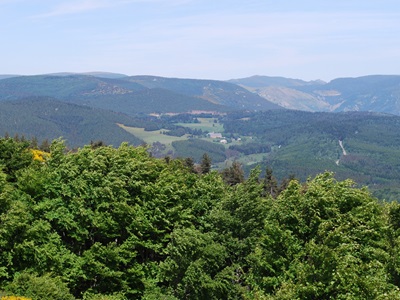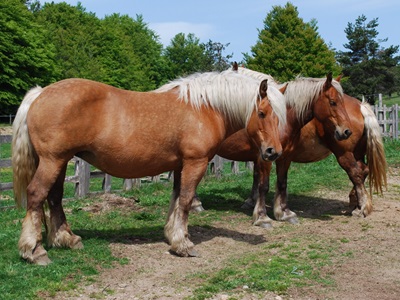The Sources of the Allier on the Moure de la Gardille |

 The summit of the Moure de la Gardille, peaking at 1,503 meters, is located to the west of La Bastide-Puylaurent. It's a true paradise for hikers, hunters, and foragers from all walks of life—a vast, grandiose no man's land encompassing 10,000 hectares of the immense forest of the former Mercoire Abbey. Here, the terrain is gentle, traced by a long panoramic ridgeline traversed by the GR7, the long-distance hiking trail connecting the Vosges to the Pyrenees, and counted among the most famous in France.
The summit of the Moure de la Gardille, peaking at 1,503 meters, is located to the west of La Bastide-Puylaurent. It's a true paradise for hikers, hunters, and foragers from all walks of life—a vast, grandiose no man's land encompassing 10,000 hectares of the immense forest of the former Mercoire Abbey. Here, the terrain is gentle, traced by a long panoramic ridgeline traversed by the GR7, the long-distance hiking trail connecting the Vosges to the Pyrenees, and counted among the most famous in France.
 From the summit, the view is spectacular. To the north and east, one can see the Mezenc, the Upper Ardeche, and Lake Charpal. To the south, two parallel chains stretch as far as the eye can see: the Goulet in the foreground and, in the background, the ridges of Mont Lozere blocking the horizon.
From the summit, the view is spectacular. To the north and east, one can see the Mezenc, the Upper Ardeche, and Lake Charpal. To the south, two parallel chains stretch as far as the eye can see: the Goulet in the foreground and, in the background, the ridges of Mont Lozere blocking the horizon.
We are perched on the roof of France, not far from the sources of the Allier, which flows towards the Loire, and the Chassezac, which empties into the Rhône. On the slopes of the Goulet massif, one also finds the sources of the Lot, destined to join the Garonne.
Just for this panorama, the ascent is worth it (only in good weather!). But today, our goal is a bit different: we are searching for the source of the Allier. We want to discover this first trickle of water and drink from it, just as one drinks from the Loire by splashing in the clear water of a "bachat" in the stable of the Gerbier.
Three hundred meters higher, we join the ridge path that will lead us to the summit of the Moure de la Gardille. The beauty of the landscape is breathtaking, and along the way, we cross paths with about thirty hikers accompanied by three pack donkeys.
 At the foot of the Moure, at the fork, we find a modest pine sign, hand-carved, indicating the source 150 meters "off trail" on the Chasserades side. We continue on foot, as from the first slope, the mountain narrows into a semblance of a ravine, plunging under the dark vault of the beech forest.
At the foot of the Moure, at the fork, we find a modest pine sign, hand-carved, indicating the source 150 meters "off trail" on the Chasserades side. We continue on foot, as from the first slope, the mountain narrows into a semblance of a ravine, plunging under the dark vault of the beech forest.
 On a carpet of dead leaves, eyes alert, we suddenly spot a trickle of water flowing into a small pond. The sun plays in the water, making its reflections sparkle through the foliage swaying in the wind—the spectacle is striking: here is the Allier, just born.
On a carpet of dead leaves, eyes alert, we suddenly spot a trickle of water flowing into a small pond. The sun plays in the water, making its reflections sparkle through the foliage swaying in the wind—the spectacle is striking: here is the Allier, just born.
But is this really the source we're looking for? In our guidebook, a pretty enameled plaque is supposed to be here, commemorating the adventure of three youths from Langeac who, in 1992, walked up the Allier from Langeac to its source in twelve days.
Whether it's the Loire, the Nile, or the Mekong, there have always been debates about the exact sources. We would have liked to avoid this kind of confusion, but here, there's no trace of the plaque. However, on the trunk of a beech tree, a painted inscription in the same yellow as the trail markers indicates "ALLIR," with a final "R." Spelling error or local dialect? Mystery.
A kilometer further, we finally arrive at a small concrete dam, inaugurated in 1995 by the mayor of Chasserades: it's the first development on the Allier. The plaque is indeed there.
 This day ends on a very positive note, especially since we prolong it in good company. On the terrace, we met two female hikers traveling the Stevenson Trail (GR70) from Monastier-sur-Gazeille to Saint-Jean-du-Gard. They speak enthusiastically about the guest house L'Étoile in La Bastide-Puylaurent.
This day ends on a very positive note, especially since we prolong it in good company. On the terrace, we met two female hikers traveling the Stevenson Trail (GR70) from Monastier-sur-Gazeille to Saint-Jean-du-Gard. They speak enthusiastically about the guest house L'Étoile in La Bastide-Puylaurent.
 The owner of the establishment left a strong impression on them: half Greek, half Belgian, musician, and adventurer in his spare time—a real character. Philippe Papadimitriou is a modern-day cowboy who boasts of having read only five books in his life. A "hands-on" man who could no doubt inform us about the source.
The owner of the establishment left a strong impression on them: half Greek, half Belgian, musician, and adventurer in his spare time—a real character. Philippe Papadimitriou is a modern-day cowboy who boasts of having read only five books in his life. A "hands-on" man who could no doubt inform us about the source.
We decide to stop by his place on the way back. The giant welcomes us with his big clear and surprised eyes: "The source of the Allier? Do I know it? No. But what does it matter?" He's right, well said, the Greek. The trickle of water under the beeches is more than enough for us. The "official" source, the "real" one? It doesn't matter. The sun is shining, the Lozere is magnificent, and life is good.
The watershed between the Cevennes and the Margeride crosses this territory, which is situated between two large drainage basins: the Rhône-Mediterranean basin and the Loire-Brittany basin. As a result, the hydrographic network of the commune is very dense, with numerous streams and "valats" (a Cevenol term for a steep stream), such as the Rieufrais stream or that of the Gouttes. On the Loire-Brittany basin side, the Allier joins the gorges of the same name, then the Loire, while the southern tributaries flow towards the Chassezac and end their course in the Ardeche, in the Rhône-Mediterranean basin.
This abundance of water allowed for the construction of a dam at Puylaurent, but it also represents a significant risk, as the territory is regularly subject to heavy rains, sometimes Cevenol episodes, causing floods. Finally, let's recall that it's west of La Bastide, near the Moure de la Gardille, in the former commune of Chasserades, that the Allier takes its source—it's here that the first trickle of water of this 420-kilometer-long river is born.
Former resort hotel with a garden on the banks of the Allier, L'Étoile Guesthouse is located in La Bastide-Puylaurent, nestled between Lozère, Ardèche, and the Cevennes in the mountains of Southern France. Positioned at the crossroads of GR®7, GR®70 Chemin Stevenson, GR®72, GR®700 Voie Regordane (Saint Gilles), GR®470 Sources and Gorges of the Allier, GRP® Cevenol, Montagne Ardechoise, and Margeride. It offers numerous loop routes for hiking and day-long cycling excursions. Ideal for a relaxing stay.
Copyright©etoile.fr